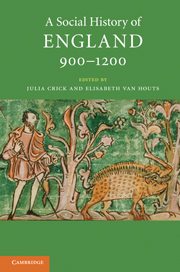Book contents
- Frontmatter
- Contents
- List of figures
- List of maps and tables
- List of contributors
- Acknowledgements
- List of abbreviations
- Map 1 England and its neighbours
- Map 2 England 900–1200
- I Introduction
- I.1 Land use and people
- I.2 Water and land
- I.3 Forest and upland
- I.4 Mineral resources
- I.5 Health and disease
- II.1 Authority and community
- II.2 Lordship and labour
- II.3 Order and justice
- II.4 War and violence
- II.5 Family, marriage, kinship
- II.6 Poor and powerless
- III.1 Towns and their hinterlands
- III.2 Commerce and markets
- III.3 Urban planning
- III.4 Urban populations and associations
- IV.1 Invasion and migration
- IV.2 Ethnicity and acculturation
- IV.3 Intermarriage
- IV.4 The Jews
- V.1 Religion and belief
- V.2 Rites of passage and pastoral care
- V.3 Saints and cults
- V.4 Public spectacle
- V.5 Textual communities (Latin)
- V.6 Textual communities (vernacular)
- VI.1 Learning and training
- VI.2 Information and its retrieval
- VI.3 Esoteric knowledge
- VI.4 Medical practice and theory
- VI.5 Subversion
- Glossary
- Time line 900–1200
- Further reading
- Index
- References
I.5 - Health and disease
Published online by Cambridge University Press: 05 June 2012
- Frontmatter
- Contents
- List of figures
- List of maps and tables
- List of contributors
- Acknowledgements
- List of abbreviations
- Map 1 England and its neighbours
- Map 2 England 900–1200
- I Introduction
- I.1 Land use and people
- I.2 Water and land
- I.3 Forest and upland
- I.4 Mineral resources
- I.5 Health and disease
- II.1 Authority and community
- II.2 Lordship and labour
- II.3 Order and justice
- II.4 War and violence
- II.5 Family, marriage, kinship
- II.6 Poor and powerless
- III.1 Towns and their hinterlands
- III.2 Commerce and markets
- III.3 Urban planning
- III.4 Urban populations and associations
- IV.1 Invasion and migration
- IV.2 Ethnicity and acculturation
- IV.3 Intermarriage
- IV.4 The Jews
- V.1 Religion and belief
- V.2 Rites of passage and pastoral care
- V.3 Saints and cults
- V.4 Public spectacle
- V.5 Textual communities (Latin)
- V.6 Textual communities (vernacular)
- VI.1 Learning and training
- VI.2 Information and its retrieval
- VI.3 Esoteric knowledge
- VI.4 Medical practice and theory
- VI.5 Subversion
- Glossary
- Time line 900–1200
- Further reading
- Index
- References
Summary
Until quite recently, historians have been obliged to rely upon documentary sources for most of their information about the health of medieval men, women and children. The most common ailments, or at least those which appeared treatable, find mention in remedy books and herbals. The lives of saints and accounts of their healing miracles likewise provide a catalogue of disease and debility, in this instance carefully chosen to reflect the superiority of spiritual over earthly medicine. Important evidence about the incidence of epidemics and famines was recorded by chroniclers, although they, in common with other medieval writers, employed a terminology that makes retrospective diagnosis difficult, if not impossible. Since the 1960s, however, advances in the study of palaeopathology (the analysis of excavated skeletal remains) have enabled us to gain a far more detailed and comprehensive picture of levels of mortality and morbidity in the years between 900 and 1200.
It is important to stress that many diseases, such as diphtheria and pneumonia, affect only the perishable soft tissue of the body, while others may prove fatal at a comparatively early stage and thus escape detection. Nor can we generalize too widely on the basis of limited data relating to particular groups of people with specific problems. Even so, skeletal evidence has proved invaluable in illuminating the lives and deaths of low-status individuals whose voices otherwise remain mute, or who are barely mentioned in the historical record.
- Type
- Chapter
- Information
- A Social History of England, 900–1200 , pp. 66 - 75Publisher: Cambridge University PressPrint publication year: 2011
References
- 2
- Cited by



